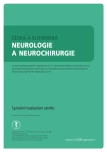Clinical features of spinal muscular atrophy in children
Authors:
J. Staněk
Authors‘ workplace:
Oddělení dětské neurologie, FN Ostrava
Published in:
Cesk Slov Neurol N 2020; 83/116(Supplementum 2): 8-12
doi:
https://doi.org/10.48095/cccsnn20202S8
Overview
Spinal muscular atrophy (SMA) is a neurodegenerative disease characterized by a loss of motor neurons in the anterior horn of the spinal cord and by resultant progressive, mainly proximal, weakness. A phenotypic spectrum includes pulmonary, gastrointestinal, nutritional complications, scoliosis and contractures. The most common form of SMA, accounting for 95% of cases, is autosomal recessive proximal SMA associated with mutations in the survival of motor neurons (SMN1) gene. It is a rare disorder with the incidence 1 : 6,000–1 : 10,000. The clinical spectrum ranges from early infant death to normal adult life with only mild weakness. SMA is classified into four types depending on the age of onset and highest level of motor function achieved. Actual treatment and multidisciplinary care change the course of the disease and improve life expectancy and quality of life.
Keywords:
spinal muscular atrophy – classification of spinal muscular atrophy – phenotype spinal muscular atrophy
Sources
1. Oskoui M, Levy G, Garland CJ et al. The changing natural history of spinal muscular atrophy type 1. Neurology 2007; 69(20): 1931–1936. doi: 10.1212/ 01.wnl.0000290830.40544.b9.
2. Haberlová J, Slabá A, Hedvičakova P et al. Spinální svalové atrofie – diagnostika, léčba, výzkum. Neurol praxi 2016; 17(6): 349–353.
3. Kolb SJ, Kissel JT. Spinal muscular atrophy a timely review. Arch Neurol 2011; 68(8): 979–984. doi: 10.1001/ archneurol.2011.74.
4. Wang CH, Finkel RS, Bertini ES et al. Consensus Stateman for standard of care in spinal muscular atrophy. J Child Neurol 2007; 22(8): 1027–1049. doi: 10.1177/ 08830 73807305788.
5. Sarnat BH, Menkes JH. Onemocnění motorické jednotky. In: Menkes JH, Sarnat HB, Maria BL. Dětská neurologie. 7th ed. Praha: Triton 2011 : 1545–1553.
6. Finkel RS, Mercuri E, Meyer OH et al. Diagnosis and management of spinal muscular atrophy: Part 2: Pulmonary and acute care; medications, supplements and immunizations; other organ systems; and ethics. Neuromuscular Disorders 2018; 28(3): 197–207. doi: 10.1016/ j.nmd.2017.11.004.
7. Ferrar MA, Vucic S, Johnston HM et al. Pathophysiological insights derived by natural history and motor function of spinal muscular atrophy. J Pediatr 2013; 162(1): 155–159. doi: 10.1016/ j.jpeds.2012.05.067.
8. Markowitz JA, Singh PP, Darras BT. Spinal muscular atrophy: a clinical and research update. Pediatr Neurol 2012; 46(1): 1–12. doi: 10.1016/ j.pediatrneurol.2011.09.001.
9. Darras BT. Spinal muscular atrophies. Pediatr Clin North Am 2015; 62(3): 743–766. doi: 1016/ j.pcl.2015.03.010.
10. Tomek A, Maťoška V, Goetz P et al. Molekulární etiopatogeneze spinální muskulární atrofie. Cesk Slov Neurol N 2002; 65(5): 313–320.
Labels
Paediatric neurology Neurosurgery NeurologyArticle was published in
Czech and Slovak Neurology and Neurosurgery

2020 Issue Supplementum 2
Most read in this issue
- Clinical manifestations of spinal muscular atrophy in adult patients
- Genetics of spinal muscular atrophy
- Therapy of spinal muscular atrophy
- Rehabilitation in spinal muscular atrophy
